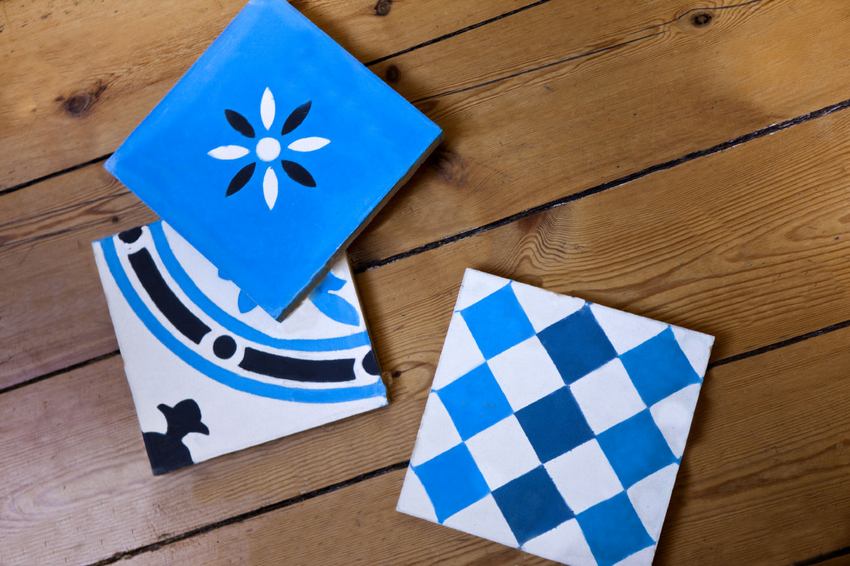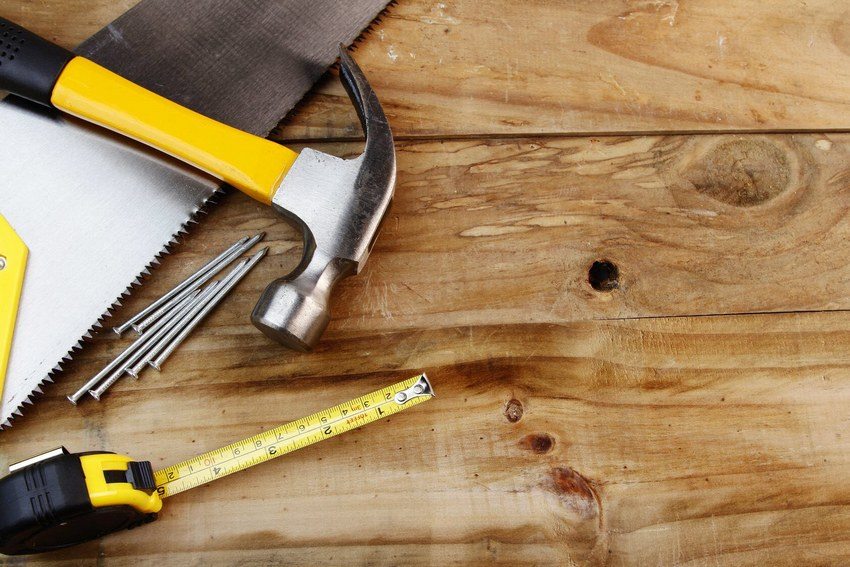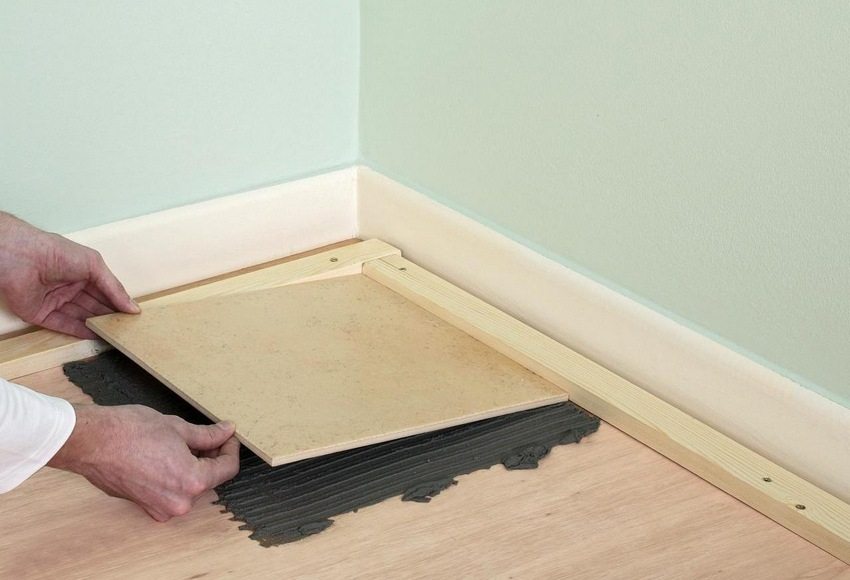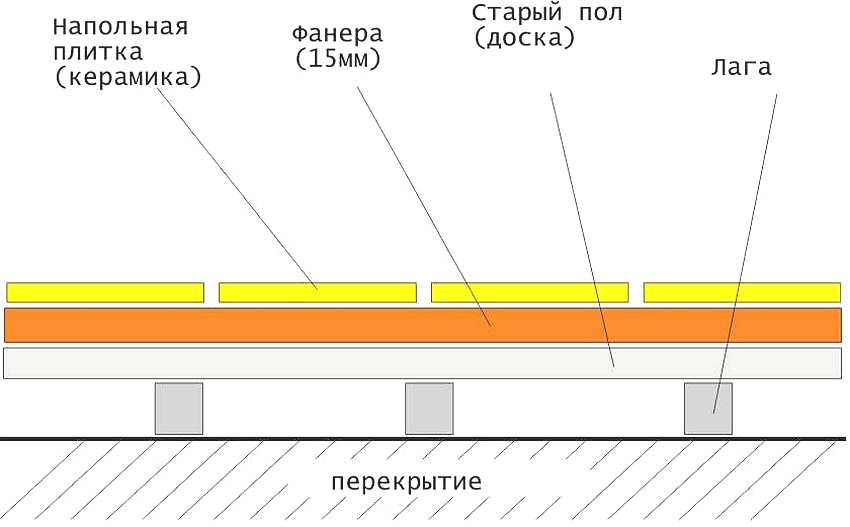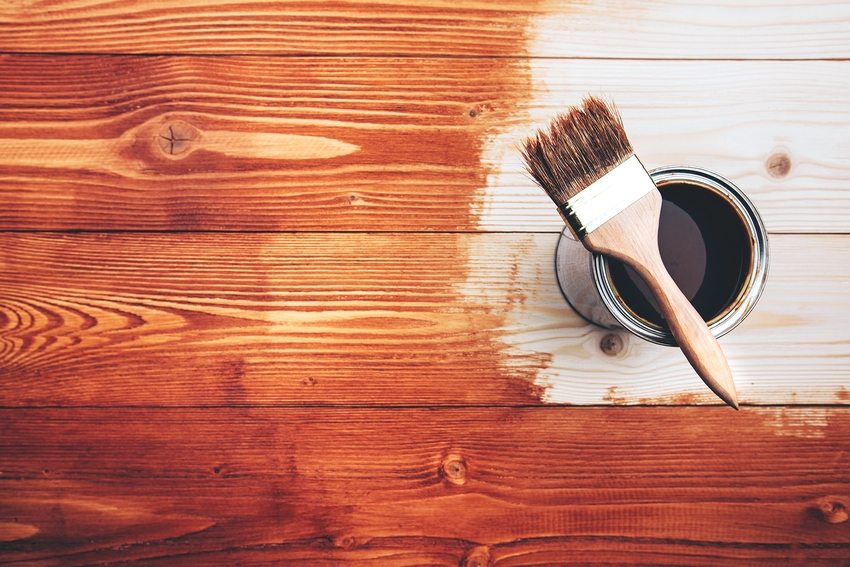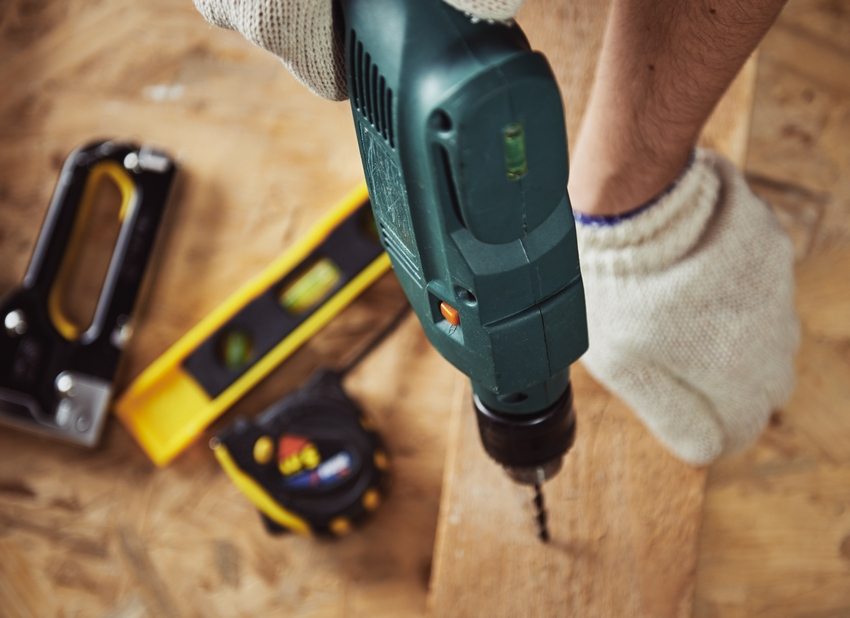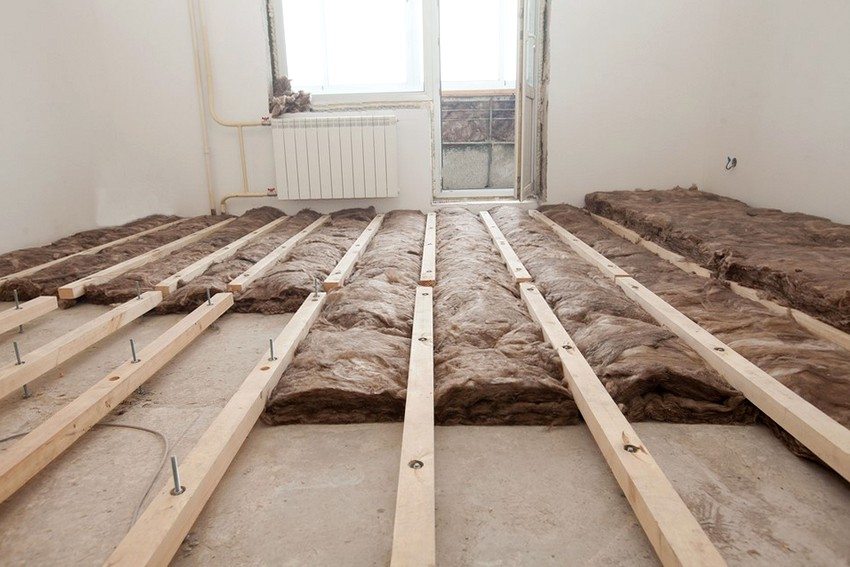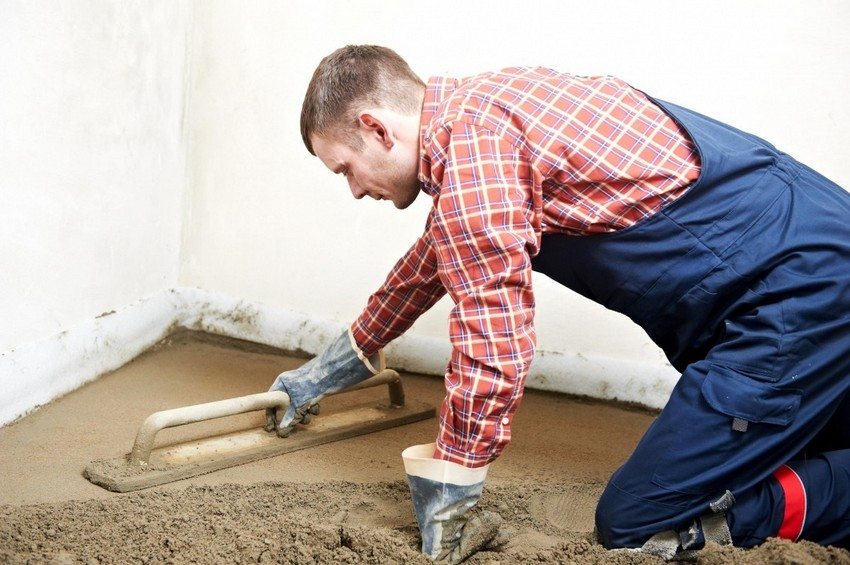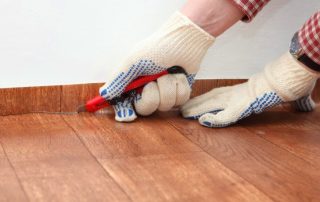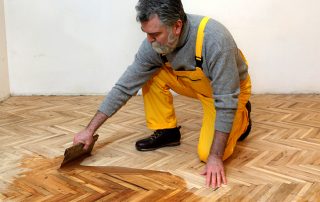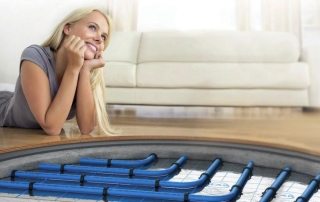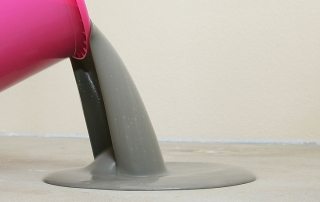The exceptional technical characteristics of the tile allowed it to be widely used not only in the decoration of the bathroom and kitchen, but also in other living rooms. Let's try to figure out how to put tiles on a wooden floor and whether it is even possible to do this. And also we will consider the main stages, features and possible difficulties that must be taken into account in the process of work.
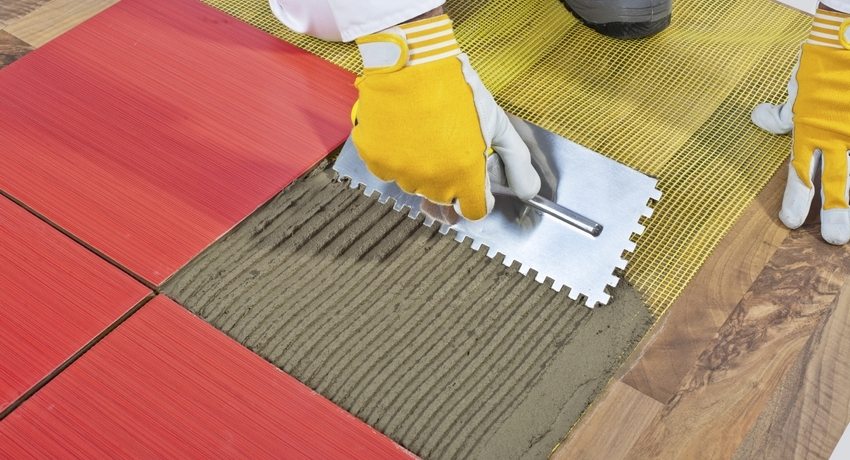
High quality laying ceramic tiles on a wooden floor will require significant effort during the preparation phase
Content
- 1 How to lay tiles on a wooden floor yourself: difficulties and features of the process
- 1.1 Assessment of the condition of the coating: can the tiles be laid on the wooden floor?
- 1.2 How to lay tiles on plywood: preparatory stages of work
- 1.3 How to lay tiles on wood floors: cleaning the planks necessary
- 1.4 How to lay ceramic tiles on wood floors: sub-flooring
- 1.5 Waterproofing layer under the tiles
- 1.6 Rough screed on a wooden floor under the tiles
- 1.7 How to lay tiles on the floor with your own hands: using a wet, semi-dry or dry screed
- 1.8 Laying of cement-bonded particle boards on a wooden floor under tiles
How to lay tiles on a wooden floor yourself: difficulties and features of the process
Generally speaking, ceramics are far from the best option to combine with wood. This is due to the different characteristics of these two materials:
- wood tends to change its size as a result of external factors: with an increase in humidity, the tree expands, with a decrease, on the contrary, it can dry out. In many cases, this leads to deformation of the tile coating and the appearance of cracks;
- unlike tiles, wood is highly susceptible to all sorts of destructive processes and is much inferior to the service life of ceramics. Therefore, it is often possible to face a situation when, due to the destruction of the wooden substrate, it is necessary to dismantle the tile;
- the tile covering, together with water-repellent glue, blocks the oxygen access to the wood, which is necessary for the full service of the wood. As a result - a significant reduction in the duration of the base's service life;
- for laying on top wood floor only the lightest tiles can be used. Otherwise, its weight will be too heavy for the wooden base and over time the tile will fail.
So, can you lay tiles on wood floors? Can. But this is a rather complicated process. If you are still confident in your decision to put ceramic tiles on top of a wooden floor, be prepared that you will need to put in a lot of effort. But the result is worth it, so let's move on to preparing the foundation. Let's consider step by step how to lay tiles on a wooden floor.
Helpful advice! It is strongly discouraged to lay tiles on top of a wooden floor that has not been installed at least two years ago. This is fraught with cracking during shrinkage.
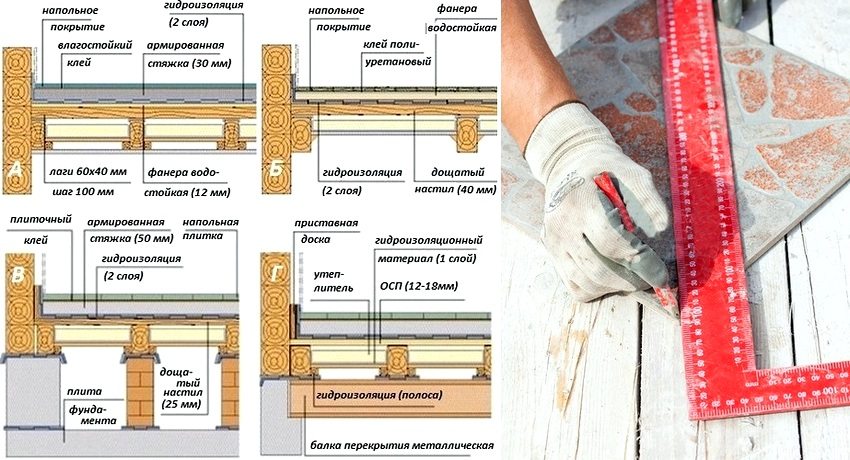
Constructive options for flooring with ceramic tiles in wooden houses: A, B - flooring over the floors; C, D - floor construction on the first floor
The main requirements for carrying out these construction works are as follows:
- provide oxygen access to the lower layers of the coating (wood);
- evenly distribute the permissible loads over the entire surface;
- ensure the immobility of the base.
In order for all these points to be observed, it is necessary to plan the order of work and follow the outlined plan. It will also be useful to watch various videos on how to put tiles on a wooden floor.
Assessment of the condition of the coating: can the tiles be laid on the wooden floor?
The first stage involves a thorough examination and assessment of the condition of the wooden base. To do this, it is best to remove the top boards and carefully examine all structural elements: beams, logs, each board on both sides, insulation, etc.
For any signs of damage, it is imperative to replace or repair the base area. What you should pay special attention to:
- the presence of rotting. There are many types of rot, so you need to carefully examine the surface. Regardless of the type of fungi that give rise to this process, the wood softens, changing its color or structure. Checking for the presence of rotting elements is performed as follows: an awl must be inserted into any fragment that arouses suspicion. Easy entry is a reliable indicator of destructive processes in wood. All affected elements must be eliminated, and the adjacent parts must be treated with special antiseptic agents for wood;
- carpenter beetle larvae. These insects destroy wood by gnawing many passages in it. To solve the problem, the same approach is used as in the first case - replacement of the damaged area and careful processing with a special compound.
Most of the destructive processes for wood develop as a result of high humidity. Therefore, installing tiles on a wooden bathroom floor requires special attention. In dry rooms, the development of fungi can occur as a result of a violation of the integrity of the insulating layer. Considering these factors, it is worth carefully checking the waterproofing materials for damage. You may need to add an extra layer.
Helpful advice! Fungal spores are found in almost any wood. The only way to prevent them from spoiling the floor is to carry out high-quality treatment with antiseptics and create the most unsuitable living conditions for them.
If none of the above flaws were found on your floor or you have already eliminated all existing defects, then you can lay the tiles on the wooden floor.
How to lay tiles on plywood: preparatory stages of work
Before you start preparing for laying ceramic tiles on a wooden floor, you must make sure that the distance between the joists does not exceed 50 cm. Otherwise, you need to install additional supports, otherwise the structure may not withstand the weight of the coating and fall through. The videos presented on the network can be used as a useful source of information: how to put tiles on a wooden floor is discussed in them in sufficient detail.
Helpful advice! Do not forget to treat all new wooden elements with antiseptics.
Next, you need to check how even the logs are, for which the building level is used. As a rule, in the process of shrinkage, irregularities appear due to uneven subsidence of wooden parts. All these defects must be eliminated by cutting off unnecessary elements with a plane or vice versa - additional lining of small pieces of bricks or any other material. If it is not possible to push the missing element under the bottom, you can fill an additional board from above, trimming it to the required height.
After leveling, it is necessary to treat the coating against fungus and bacteria. To do this, use the product with the longest possible interval between repeated treatments and follow all the recommendations specified in the instructions.
The most common surface treatment before laying ceramic tiles on a wooden floor is hot drying oil. For quality protection, it must be reapplied several times (up to five). The product is a completely natural, environmentally friendly impregnation. Each next layer of drying oil is applied after the previous one has completely dried. You can make sure that it is dry by touching the surface - it should not be sticky.
The main thing in the process of processing drying oil is not to let it cool down, because its antiseptic effect directly depends on the temperature: the hotter it is, the better it destroys larvae, spores and bacteria. In addition, in a hot state, drying oil is more liquid and can penetrate deeper into micro-crevices.
Helpful advice! Heating drying oil is an unsafe process. Its vapors can be flammable, so it is strictly forbidden to place the container on the stove. While heating the septic tank, hold it over the stove and, just in case, prepare a piece of tarpaulin that can be used to extinguish the ignition source.
How to lay tiles on wood floors: cleaning the planks necessary
If all previously removed boards are in satisfactory condition, they can be reinstalled, having previously been cleaned of the old varnish or paint with which they were covered. This can be done while you are waiting for the antiseptic solution to dry completely.
The following methods can be used to remove residual varnish and paint from the surface of the boards:
- construction hair dryer, set to a temperature of 200-250 ° C. A stream of hot air must be directed at the paint, as a result of which it will begin to bubble up. Use a spatula, knife or scraper to remove it. In some sources you can find recommendations for using blowtorches, but this is not a good idea. The probability of wood overheating is high, and, as a result, deterioration of its technical characteristics;
- chemical washes are gel-like mass and are sold in almost all hardware stores. Such a remover must be evenly applied to the surface and after a while removed with a spatula along with the softened paint. The only drawback of this method is the considerable cost of the material when it comes to processing a large floor area;
- mechanical cleaning involves peeling paint off the surface with a spatula or sandpaper without the use of auxiliary materials. It's cheap but very time consuming. The grinding machine will help speed up the process at times.
If, after removing the coating, you find any defects that were not noticed before, it is better to replace the damaged areas. In addition, all boards are subject to an antibacterial treatment. After the impregnation is completely absorbed, you can start laying the sub-floor under the tiles.
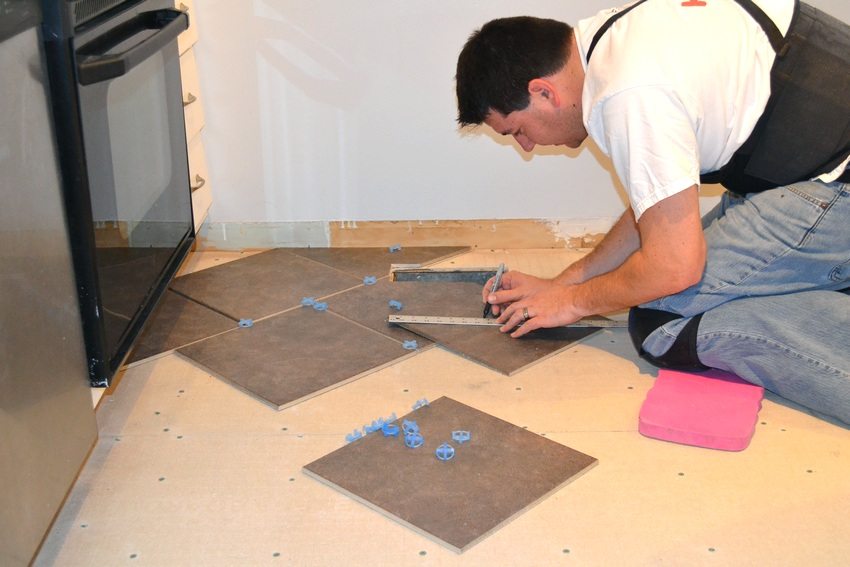
For leveling the floor before laying the tiles, various materials are used, for example, Fiberboard
How to lay ceramic tiles on wood floors: sub-flooring
The process of sub-flooring begins with the laying of an insulating layer. The material you choose must be non-absorbent. This will keep the tiles dry and prevent bacteria and fungi from growing there. Also, the material should have a minimum weight in order to create as little stress as possible.
Extruded polypropylene foam can be considered a suitable option. Due to its synthetic origin, it prevents the development of any living organisms on its surface. True, this material also has disadvantages: it does not allow air to pass through well and has a considerable cost.
Alternatively, you can use expanded clay. It is natural and conducts air perfectly. However, it has more weight and a more hygroscopic structure.
Whatever insulation you prefer, it must be laid out on top of the layer waterproofing... Old boards are placed on top, leaving gaps from 4 mm to 1 cm between them and near the walls. These slots will not be visible as they will close skirting boards, and at the same time will give the wood the opportunity to expand in the event of an increase in moisture.
If you want a warm floor under tiles on a wooden floor, then in this case it is better to seek professional help. The installation of the system is quite complex and requires a certain level of skill.
When all the boards are laid and secured, they can be putty and then smoothed using a sander. All cracks must be sealed with polyurethane foam. It is resilient enough to allow the wood to expand, while also supporting the weight of the tiles and glue.
Related article:
Floor tiles for the corridor and kitchen: photos, tips for choosing and laying. Ideal tiles for the hallway and kitchen: photos of the best finishes. Advantages and disadvantages of tiles. How to choose and lay tiles: recommendations.
Waterproofing layer under the tiles
Particularly careful waterproofing requires laying tiles on a wooden floor in the bathroom, however, in other rooms this should be paid attention to. The floor surface is several times covered with hot linseed oil or special latex impregnation and immediately, without waiting for it to dry, a painting net is laid on top. The overlap between the layers should be 5-10 cm.
Waterproofing a wooden floor under a tile in a bathroom requires particularly careful fulfillment of all regulations due to the constant high humidity in the room.
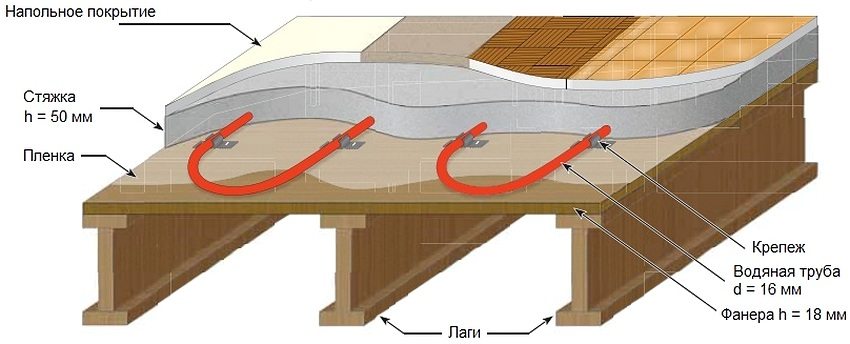
Device diagram warm floor under the tiles or laminate in a wooden house
Rough screed on a wooden floor under the tiles
For reliable fastening of the tile, it is necessary to create a high-quality and rigid base. For this purpose, a rough screed is made: a metal reinforcing mesh with a wire diameter of 3-5 mm and a pitch of 20 cm is laid on top of the waterproofing layer.All this is covered with a fairly thin (3-4 cm) layer of cement mortar.
Helpful advice! Do not try to pour a thinner layer of cement, as this is fraught with spreading of the solution.
How to lay tiles on the floor with your own hands: using a wet, semi-dry or dry screed
For a wet screed, you can use a ready-made cement-sand mortar, which is sold in stores. Its composition can be improved with various additives. For example, fiberglass can be added for greater strength and elasticity. It is convenient to use polymer screeds. But their use as a roughing coating in most cases is not justified due to the high price.
In addition, there are instructions for making your own polymer screeds. In the simplest version, take:liquid glass (2 parts), pre-sieved and washed coarse sand (also 2 parts) and water (1 part).All these components are mixed and poured. The resulting coating has increased elasticity and strength.
Helpful advice! As a substitute for fiberglass, a two-component polyurethane adhesive can be added to the solution.
A dry screed can be made using sheets of drywall, gypsum board or particle board. Sometimes moisture-resistant plywood is used. Such a solution to the screed problem is quite acceptable, but only in very dry rooms. If you are laying tiles on a wooden floor in the kitchen or bathroom, a wet or semi-dry screed is required.
The use of DSP or GVL on a wooden floor under tiles in rooms with high humidity is unacceptable.
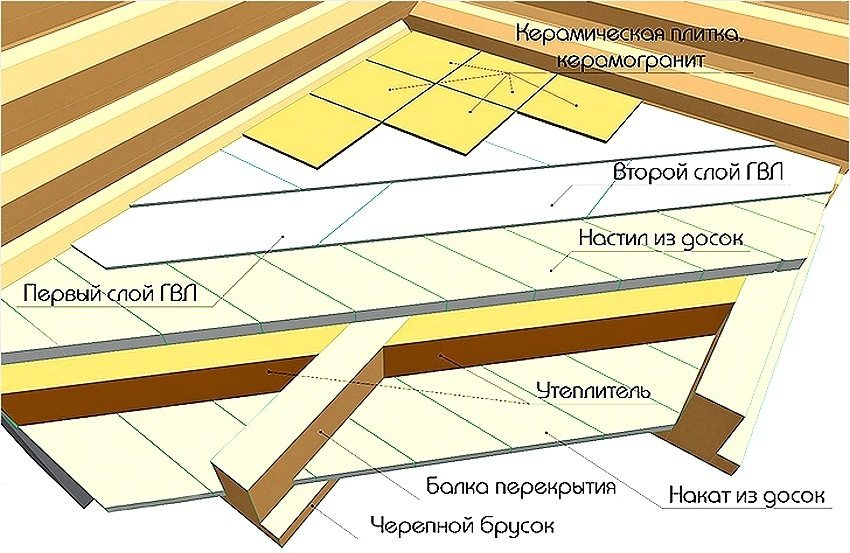
Scheme laying ceramic tiles on the wooden floor in the bathroom
Laying of cement-bonded particle boards on a wooden floor under tiles
Laying tiles on DSP, as well as on other sheet materials, is subject to certain rules:
- the joints of the sheets and the joints of the lags should not coincide with each other;
- before putting the tiles on the DSP, the sheets must be fixed with self-tapping screws at a distance of 25-30 cm from each other;
- all seams are sealed with a special solution for moisture-resistant drywall;
- after complete drying, the seams must be sanded.
All instructions on how to properly lay tiles on a wooden floor indicate that tiles are laid on a properly prepared base according to the standard scheme. First you need to mix the purchased adhesive solution as indicated in the instructions. It must be applied both on the floor and on the back of the tile. The furrows to be left should diverge in different directions for better traction.
It is necessary to start laying from the wall, while it is desirable from a well-visible place so that all trimmed elements are out of sight. You can study various materials on how to lay tiles on a wooden floor: videos will be good helpers in the process of work.
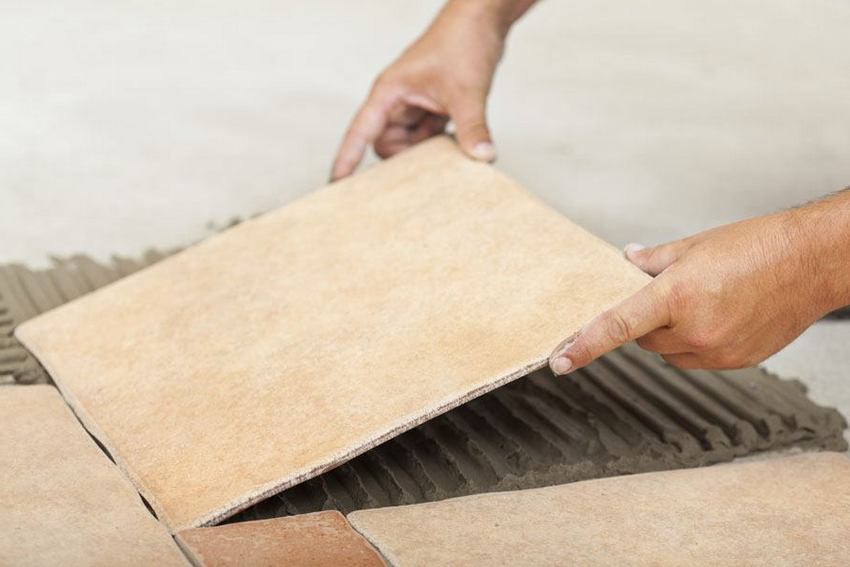
The use of cement-bonded particle boards allows you to obtain a perfectly flat surface, which greatly facilitates the laying of tiles
After the small piece has been laid, level the tile with a level and a rubber mallet. Apart from the rather complicated preparatory work, laying tiles on a wooden floor in a wooden house is quite simple. The use of DSP slabs for the floor under the tiles allows you to create the most even surface, which greatly facilitates the task.
The answer to the question of whether it is possible to put tiles on a wooden floor is unequivocal. And while it will take a lot of effort compared to other materials, the result is well worth the time. You can always resort to the help of additional sources of information on the preparatory work on how to lay the tiles on the floor with your own hands (video and photo). In addition, it is possible to install even warm floors in a wooden house under tiles, which allows you to get a high level of comfort.
